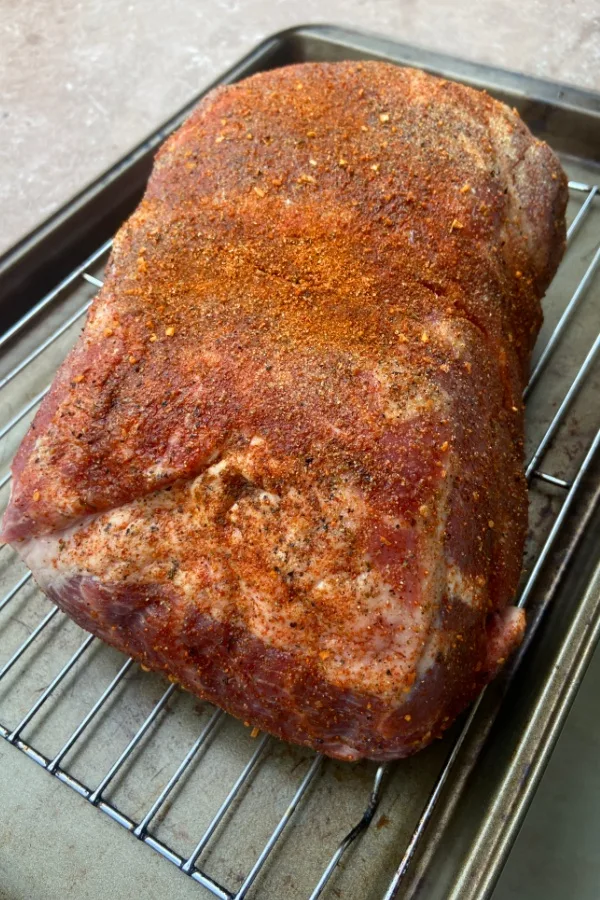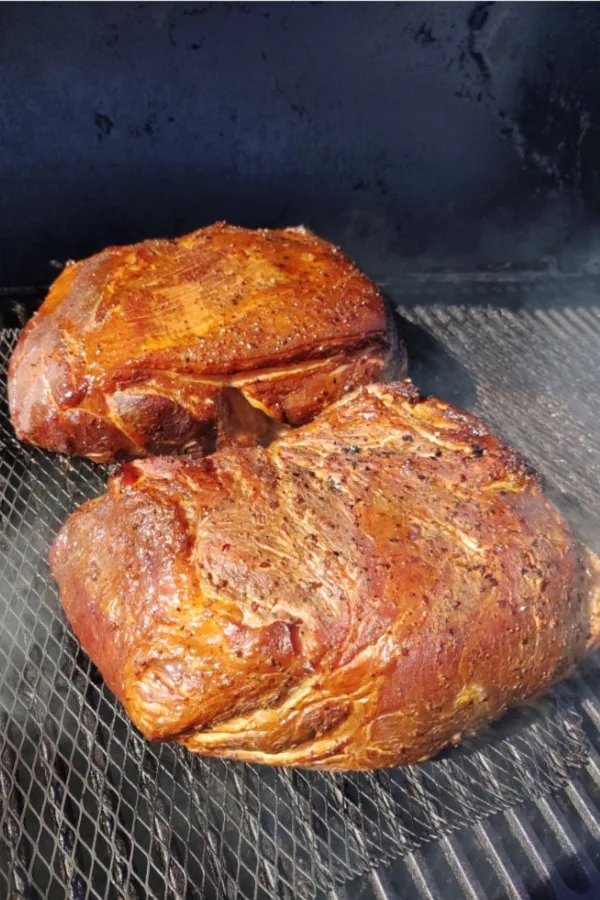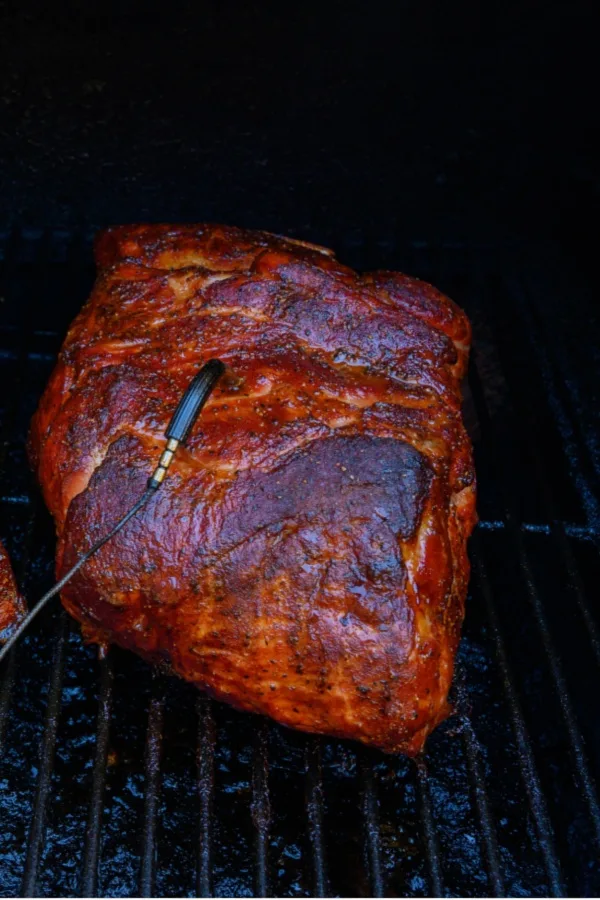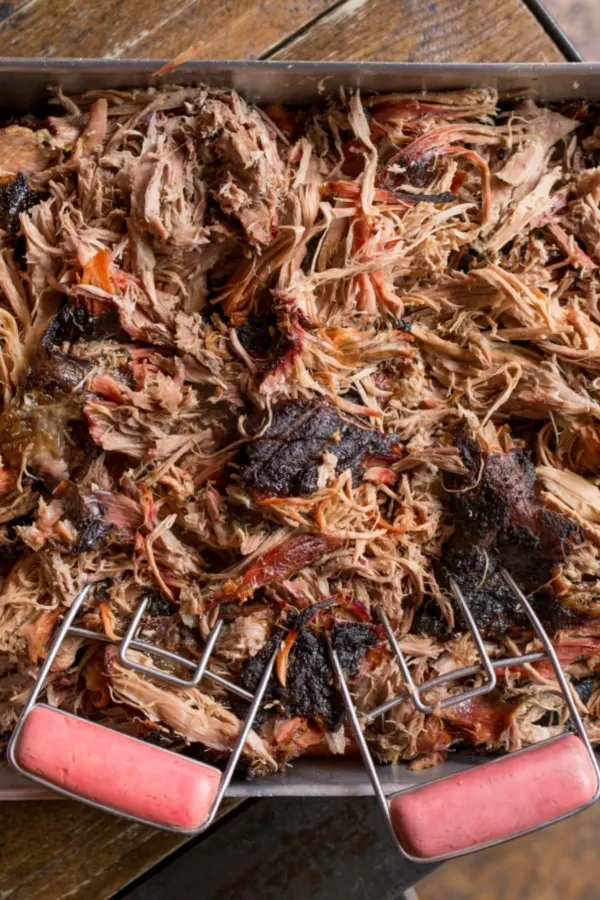When it comes to hosting a backyard barbecue it is hard to beat the taste of Smoked Pulled Pork. Tender, fall off the bone pork that is easy to shred and to serve on buns, in a tortilla shell or as a stand alone main dish.
Best of all, it is super easy to make. In fact, even the novice outdoor cook can master this recipe that requires only 3 ingredients.
However in order for you to get the best tasting and the juiciest meat that you have ever had, a little patience is required. Although this recipe is simple, it takes nearly all day to cook in your smoker.
However, the results are well worth the time. When cooked low and slow the flavor of the meat is so good that you don’t even need to drench it in barbecue sauce.
Although when serving it I always leave a bottle of barbecue sauce on the table as an option to put on sandwiches or as a side for dipping.
Best Cut of Meat For Smoked Pulled Pork
When it comes to picking out the best cut of meat for making pulled pork it is best to use a pork butt roast. This is the same cut of meat when I make my Crock Pot Barbecue Pulled Pork Recipe.
Although the name might suggest that this cut of meat comes from the actual hind end of a pig, it doesn’t. In fact, it comes from the top section of the shoulder of the pig.
You can easily find this cut of meat in just about every grocery store. However, you may recognize it by a different name. It is often called Boston Butt in many areas of the country.
You can also use a Pork Shoulder Roast (aka picnic roast) to make Smoked Pulled Pork as well. This cut of meat also comes from the pig’s leg, but is located just below the pork butt.
It has a little less marbled fat throughout the fibers, but when cooked low and slow, it also shreds easily. So when you had to the grocery first search for a pork butt, but a good second option is a pork shoulder roast.
Plan For Enough Time
Once you have your roast, it is time to prepare to put it in the smoker. But before you begin, make sure that you have an entire day available to monitor the temperature of both your smoker and the internal temperature of your meat.
This is a long and slow cooking process. You need to plan for 1 1/2 -2 hours of cooking time per pound, plus an additional hour for the meat to rest once it comes out of the smoker.
When I make an 8 pound roast it takes approximately 13 hours to cook in our electric smoker. But the results are always a fall apart, tender and juicy, smoked pulled pork!
Dry Rub
Before the pork butt goes into the smoker, you must add a dry rub over the entire surface.
You can use whatever dry rub that you prefer. I have used both McCormick’s Applewood Rub and my homemade dry rub and both turn out fantastic.
When I make our own Homemade Dry Rub, I use the same recipe that we use to rub on our Smoked Chicken. The flavor is outstanding and is perfect to use when smoking either chicken or pork.
However, when making pulled pork, I recommend rubbing yellow mustard instead of oil on the meat’s surface prior to applying the dry rub.
The mustard helps break down the fibers in the smoked pulled pork and adds just a thin layer of crust to the surface which is often sought after in traditional barbecue recipes.
Now that your meat is coated with your dry rub it is time to put it in the smoker!
The Smoking Process
For the best smoked pulled pork set your smoker temperature to 225°F. Then when it comes to the type of wood chips or pellets to use I recommend apple, hickory or pecan wood.
Once your smoker is ready be sure to place your seasoned pork away from direct heat (if using a barrel smoker) and with the fat side facing up.
Let the roast smoke, adding additional wood chips as needed, until a digital food thermometer inserted into the middle of the roasts reads 201°F. Just be aware that around the 150°-170° mark, your roast will go into a stall period.
It will seem like your meat is never going to increase in temperature. However, give it time (sometimes 2-3 hours) and eventually, it will begin to increase again.
During the stall period you have the option of wrapping the roast in foil or butcher paper or spraying it with root beer or Coke/Pepsi. This will help prevent the roast from drying out during that stall period.
Once the stall period breaks, continue to smoke it until the internal temperature reaches 201°F. Then pull the pork roast out of the smoker and wrap it in butcher paper or foil.
Rest Time Required
It is best to let the meat rest for an hour before shredding. To keep the roast warm, wrap a towel around the wrapped smoked pork butt and place it in a cooler.
Once it has been resting for an hour unwrap it and shred. The meat will literally fall apart with just a slight pull between two forks.
And since you already have your smoker out, how about smoking some Baby Back Ribs, Chicken Wings or a Smoked Pineapple to go along with your Pulled Pork!
The Best Smoked Pulled Pork Recipe
*Complete recipe instructions including specific measurements, cook temperatures and times are located in a printable recipe card at the bottom of this article. However, be sure to keep reading for helpful tips and tricks when making this recipe.
INGREDIENTS
- 8-10 pound, bone-in pork butt or shoulder roast
- 2 TBSP yellow mustard
- 1/4 cup BBQ Rub
INSTRUCTIONS
Preheat your smoker to 225°F. Then add your apple, pecan or hickory wood chips to the smoker box.
Remove your roast from the packaging and pat it down with paper towels to remove any moisture. Coat the entire exterior of the roast with yellow mustard.
Sprinkle the BBQ Rub Seasoning all over the roast, on all sides. Then place your seasoned roast, fat side up in the smoker, away from direct heat.
Close the lid and smoke the pork until it reaches an internal temperature of at least 201°F. Plan on smoking your pork butt for approximately 1 1/2 – 2 hours per pound.
Remove the pork roast from the smoker and wrap it tightly in foil.
Allow the roast to rest for at least an hour before shredding. Use two forks or two meat claws to shred the roast, discarding any chunks of fat or gristle.
Serve the smoked pulled pork immediately plain or with your favorite barbecue sauce.
Enjoy!
Mary and Jim

Jim and Mary Competti have been writing gardening, DIY and recipe articles and books for over 15 years from their 46 acre Ohio farm. The two are frequent speakers on all things gardening and love to travel in their spare time.
As always, feel free to email us at thefarm@owgarden.com with comments, questions, or to simply say hello! You can sign up for our free email list in the subscribe now box in the middle of this article. Follow us on Facebook here : OWG Facebook. This article may contain affiliate links.
Simple Pulled Pork Recipe
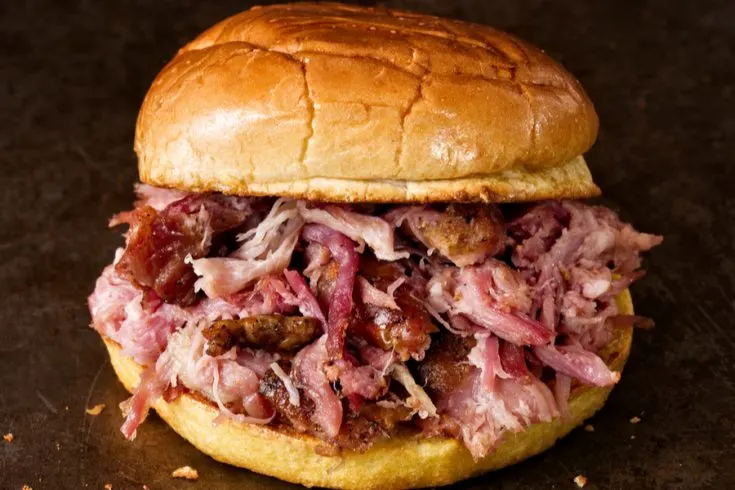
Fall apart, tender and juicy, shreds of smoked pork that will literally melt in your mouth. Use the meat for sandwiches, tacos, salads or serve naked for a low-carb main dish.
Ingredients
- 1 8-10 pound, bone-in pork butt or shoulder roast
- 2 TBSP yellow mustard
- 1/4 cup BBQ Rub
Instructions
- Preheat your smoker to 225 degrees F. Add your apple, pecan or hickory wood chips to the smoker box.
- Remove your roast from the packaging and pat it down with paper towels to remove any moisture.
- Coat the entire exterior of the roast with yellow mustard.
- Sprinkle the BBQ Rub Seasoning all over the roast, on all sides.
- Place your seasoned roast, fat side up, in the smoker, away from direct heat.
- Close the lid and smoke the pork until it reaches an internal temperature of at least 201 degrees F. Plan on smoking yor pork shoulder for approximately 1 1/2 - 2 hours per pound.
- Remove the pork shoulder from the smoker and wrap tightly in foil. Allow the roast to rest for at least an hour before shredding.
- Pull apart the shoulder, discarding any chunks of fat or gristle.
- Serve immediately plain or with your favorite barbecue sauce.
Notes
Recipe courtesy of Old World Garden Farms
Nutrition Information:
Yield:
20Serving Size:
1 gramsAmount Per Serving: Calories: 616Total Fat: 43gSaturated Fat: 16gTrans Fat: 0gUnsaturated Fat: 23gCholesterol: 196mgSodium: 190mgCarbohydrates: 1gFiber: 0gSugar: 0gProtein: 53g
Nutritional Information is to be used as a general guideline only . Nutritional calculations will vary from the types and brands of the products used.


